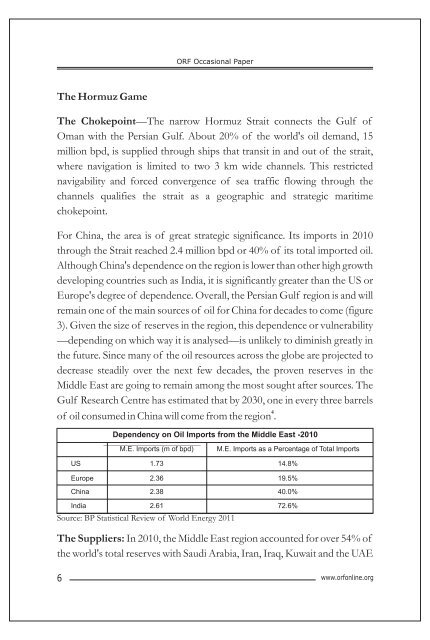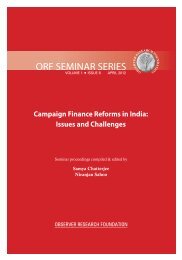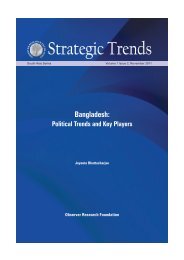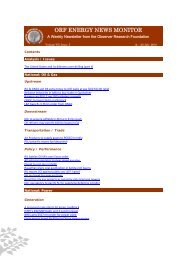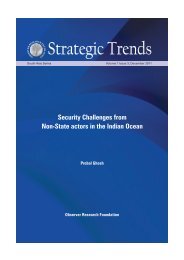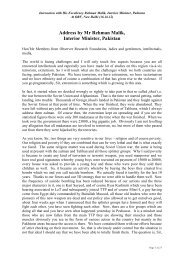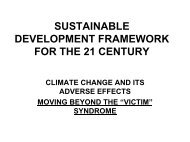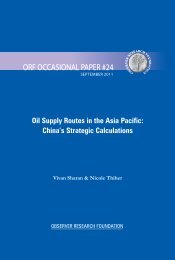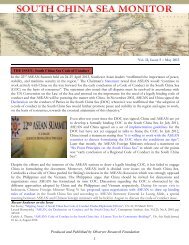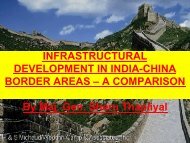Oil Supply Routes in the Asia Pacific: China's Strategic Calculations
Oil Supply Routes in the Asia Pacific: China's Strategic Calculations
Oil Supply Routes in the Asia Pacific: China's Strategic Calculations
Create successful ePaper yourself
Turn your PDF publications into a flip-book with our unique Google optimized e-Paper software.
ORF Occasional Paper<br />
The Hormuz Game<br />
The Chokepo<strong>in</strong>t—The narrow Hormuz Strait connects <strong>the</strong> Gulf of<br />
Oman with <strong>the</strong> Persian Gulf. About 20% of <strong>the</strong> world's oil demand, 15<br />
million bpd, is supplied through ships that transit <strong>in</strong> and out of <strong>the</strong> strait,<br />
where navigation is limited to two 3 km wide channels. This restricted<br />
navigability and forced convergence of sea traffic flow<strong>in</strong>g through <strong>the</strong><br />
channels qualifies <strong>the</strong> strait as a geographic and strategic maritime<br />
chokepo<strong>in</strong>t.<br />
For Ch<strong>in</strong>a, <strong>the</strong> area is of great strategic significance. Its imports <strong>in</strong> 2010<br />
through <strong>the</strong> Strait reached 2.4 million bpd or 40% of its total imported oil.<br />
Although Ch<strong>in</strong>a's dependence on <strong>the</strong> region is lower than o<strong>the</strong>r high growth<br />
develop<strong>in</strong>g countries such as India, it is significantly greater than <strong>the</strong> US or<br />
Europe's degree of dependence. Overall, <strong>the</strong> Persian Gulf region is and will<br />
rema<strong>in</strong> one of <strong>the</strong> ma<strong>in</strong> sources of oil for Ch<strong>in</strong>a for decades to come (figure<br />
3). Given <strong>the</strong> size of reserves <strong>in</strong> <strong>the</strong> region, this dependence or vulnerability<br />
—depend<strong>in</strong>g on which way it is analysed—is unlikely to dim<strong>in</strong>ish greatly <strong>in</strong><br />
<strong>the</strong> future. S<strong>in</strong>ce many of <strong>the</strong> oil resources across <strong>the</strong> globe are projected to<br />
decrease steadily over <strong>the</strong> next few decades, <strong>the</strong> proven reserves <strong>in</strong> <strong>the</strong><br />
Middle East are go<strong>in</strong>g to rema<strong>in</strong> among <strong>the</strong> most sought after sources. The<br />
Gulf Research Centre has estimated that by 2030, one <strong>in</strong> every three barrels<br />
4<br />
of oil consumed <strong>in</strong> Ch<strong>in</strong>a will come from <strong>the</strong> region .<br />
Dependency on <strong>Oil</strong> Imports from <strong>the</strong> Middle East -2010<br />
M.E. Imports (m of bpd)<br />
M.E. Imports as a Percentage of Total Imports<br />
US 1.73 14.8%<br />
Europe 2.36 19.5%<br />
Ch<strong>in</strong>a 2.38 40.0%<br />
India 2.61 72.6%<br />
Source: BP Statistical Review of World Energy 2011<br />
The Suppliers: In 2010, <strong>the</strong> Middle East region accounted for over 54% of<br />
<strong>the</strong> world's total reserves with Saudi Arabia, Iran, Iraq, Kuwait and <strong>the</strong> UAE<br />
6<br />
www.orfonl<strong>in</strong>e.org


